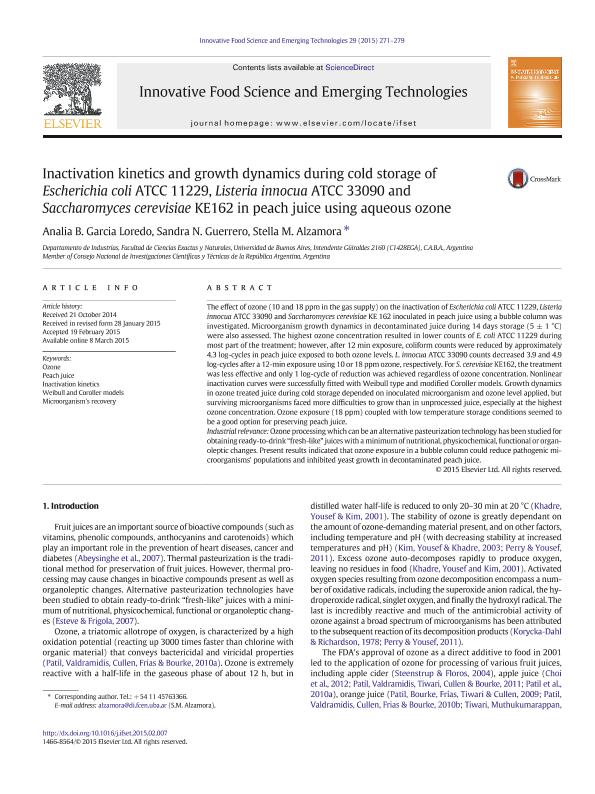Mostrar el registro sencillo del ítem
dc.contributor.author
Garcia Loredo, Analia Belen

dc.contributor.author
Guerrero, Sandra N.

dc.contributor.author
Alzamora, Stella Maris

dc.date.available
2018-03-06T20:47:00Z
dc.date.issued
2015-05
dc.identifier.citation
Garcia Loredo, Analia Belen; Guerrero, Sandra N.; Alzamora, Stella Maris; Inactivation kinetics and growth dynamics during cold storage of Escherichia coli ATCC 11229, Listeria innocua ATCC 33090 and Saccharomyces cerevisiae KE162 in peach juice using aqueous ozone; Elsevier; Innovative Food Science & Emerging Technologies; 29; 5-2015; 271-279
dc.identifier.issn
1466-8564
dc.identifier.uri
http://hdl.handle.net/11336/38078
dc.description.abstract
The effect of ozone (10 and 18 ppm in the gas supply) on the inactivation of Escherichia coli ATCC 11229, Listeria innocua ATCC 33090 and Saccharomyces cerevisiae KE 162 inoculated in peach juice using a bubble column was investigated. Microorganism growth dynamics in decontaminated juice during 14 days storage (5 ± 1 °C) were also assessed. The highest ozone concentration resulted in lower counts of E. coli ATCC 11229 during most part of the treatment; however, after 12 min exposure, coliform counts were reduced by approximately 4.3 log-cycles in peach juice exposed to both ozone levels. L. innocua ATCC 33090 counts decreased 3.9 and 4.9 log-cycles after a 12-min exposure using 10 or 18 ppm ozone, respectively. For S. cerevisiae KE162, the treatment was less effective and only 1 log-cycle of reduction was achieved regardless of ozone concentration. Nonlinear inactivation curves were successfully fitted with Weibull type and modified Coroller models. Growth dynamics in ozone treated juice during cold storage depended on inoculated microorganism and ozone level applied, but surviving microorganisms faced more difficulties to grow than in unprocessed juice, especially at the highest ozone concentration. Ozone exposure (18 ppm) coupled with low temperature storage conditions seemed to be a good option for preserving peach juice. Industrial relevance Ozone processing which can be an alternative pasteurization technology has been studied for obtaining ready-to-drink "fresh-like" juices with a minimum of nutritional, physicochemical, functional or organoleptic changes. Present results indicated that ozone exposure in a bubble column could reduce pathogenic microorganisms' populations and inhibited yeast growth in decontaminated peach juice.
dc.format
application/pdf
dc.language.iso
eng
dc.publisher
Elsevier

dc.rights
info:eu-repo/semantics/openAccess
dc.rights.uri
https://creativecommons.org/licenses/by-nc-sa/2.5/ar/
dc.subject
Ozone
dc.subject
Peach Juice
dc.subject
Inactivation Kinetics
dc.subject.classification
Alimentos y Bebidas

dc.subject.classification
Otras Ingenierías y Tecnologías

dc.subject.classification
INGENIERÍAS Y TECNOLOGÍAS

dc.title
Inactivation kinetics and growth dynamics during cold storage of Escherichia coli ATCC 11229, Listeria innocua ATCC 33090 and Saccharomyces cerevisiae KE162 in peach juice using aqueous ozone
dc.type
info:eu-repo/semantics/article
dc.type
info:ar-repo/semantics/artículo
dc.type
info:eu-repo/semantics/publishedVersion
dc.date.updated
2018-03-06T17:45:07Z
dc.journal.volume
29
dc.journal.pagination
271-279
dc.journal.pais
Países Bajos

dc.journal.ciudad
Amsterdam
dc.description.fil
Fil: Garcia Loredo, Analia Belen. Universidad de Buenos Aires; Argentina. Consejo Nacional de Investigaciones Científicas y Técnicas; Argentina
dc.description.fil
Fil: Guerrero, Sandra N.. Universidad de Buenos Aires; Argentina. Consejo Nacional de Investigaciones Científicas y Técnicas; Argentina
dc.description.fil
Fil: Alzamora, Stella Maris. Universidad de Buenos Aires; Argentina. Consejo Nacional de Investigaciones Científicas y Técnicas; Argentina
dc.journal.title
Innovative Food Science & Emerging Technologies

dc.relation.alternativeid
info:eu-repo/semantics/altIdentifier/doi/http://dx.doi.org/10.1016/j.ifset.2015.02.007
Archivos asociados
